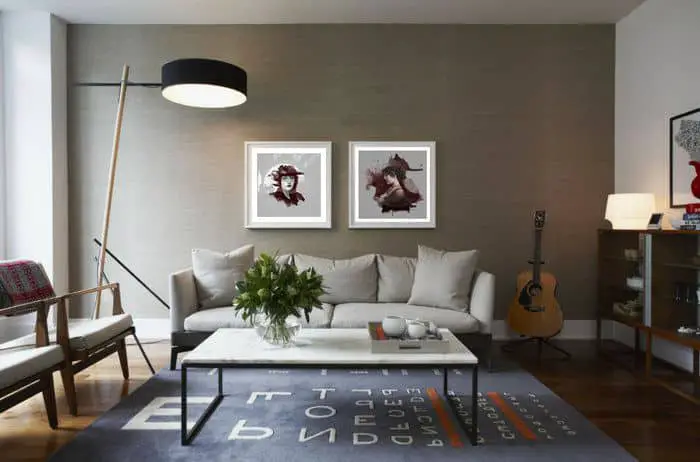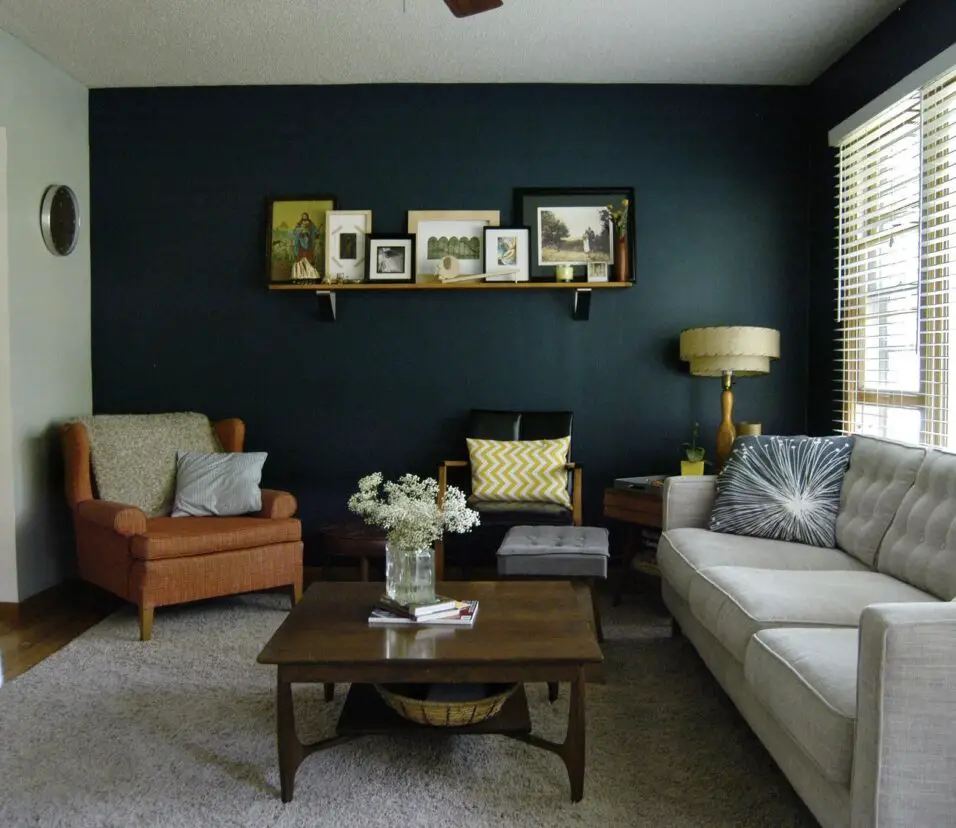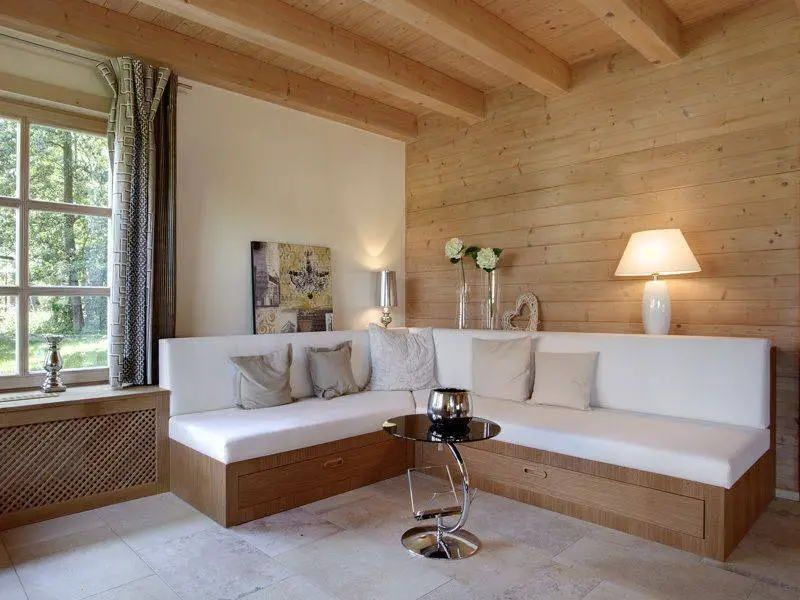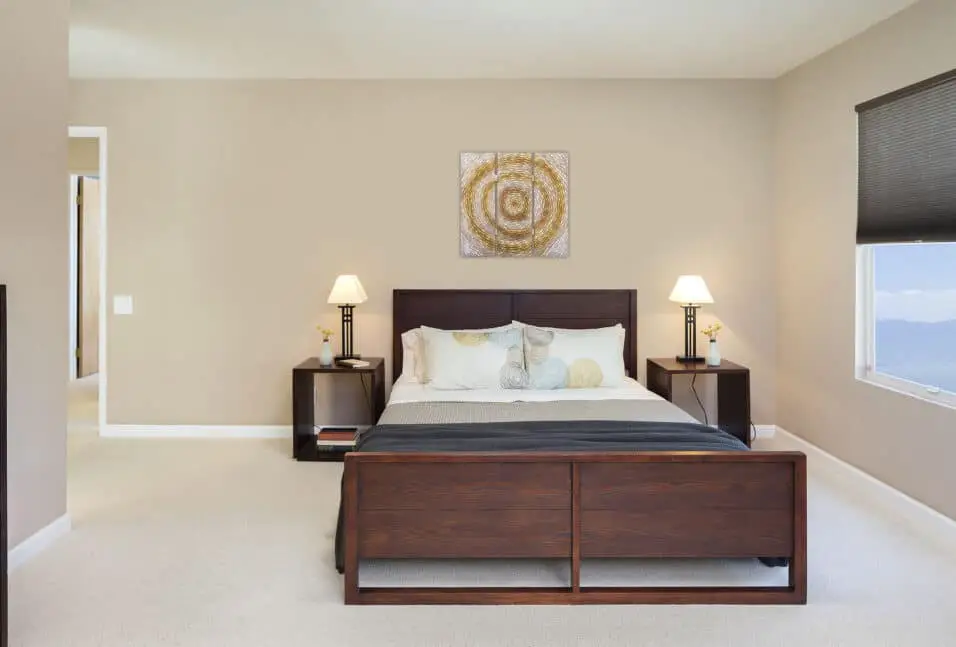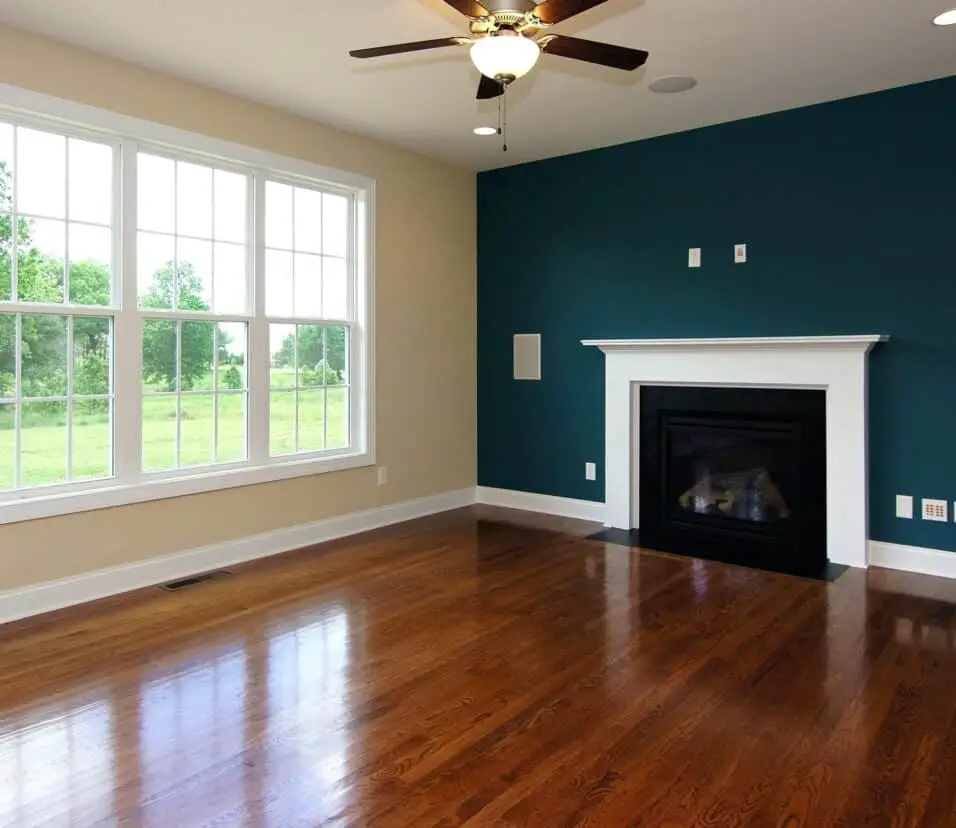What Color Accent Wall Goes With Grey
Introduction
Choosing the right color for an accent wall can greatly enhance the overall aesthetic appeal of a room. When it comes to pairing an accent wall with the timeless and versatile color of grey, the possibilities are endless. Grey is a neutral color that provides a sophisticated and calming backdrop, making it an ideal choice for many interior design styles. However, selecting the perfect color to complement grey can be a daunting task, as it requires careful consideration of various factors such as the room’s purpose, lighting, and personal preferences.
Grey, often associated with elegance and modernity, serves as an excellent base color for accent walls. It effortlessly blends with a wide range of hues, allowing homeowners to create a harmonious and visually appealing space. Whether you prefer a bold and vibrant look or a subtle and understated ambiance, there is a color that can perfectly complement grey.
One popular option for accentuating a grey wall is to choose a complementary color. Complementary colors are those that are opposite each other on the color wheel, creating a striking contrast. For instance, a warm and inviting shade like mustard yellow can beautifully offset the coolness of grey, adding a pop of color and creating a visually captivating focal point in the room. Similarly, a deep shade of teal or turquoise can create a stunning contrast against a light grey wall, infusing the space with a sense of energy and vibrancy.
On the other hand, if you prefer a more harmonious and soothing atmosphere, analogous colors can be an excellent choice. Analogous colors are those that are adjacent to each other on the color wheel, creating a sense of unity and cohesion. For a serene and calming ambiance, consider pairing a soft shade of blue or green with grey. These colors work together to create a tranquil and relaxing environment, perfect for bedrooms or living rooms where you want to unwind after a long day.
Another approach to selecting a color for an accent wall is to consider the overall mood and style you want to achieve in the room. For a contemporary and minimalist look, a crisp white accent wall can complement grey, creating a clean and sophisticated space. Alternatively, if you desire a more dramatic and luxurious atmosphere, a deep shade of burgundy or plum can add richness and depth to the room, making a bold statement against the grey backdrop.
When choosing a color for an accent wall to go with grey, it is essential to consider factors such as complementary or analogous colors, the desired mood, and the overall style of the room. By carefully selecting the right color, you can create a visually stunning and harmonious space that reflects your personal taste and enhances the beauty of grey.

What accent wall color goes good with gray?
Decorating with gray is a versatile color to scheme with as it can carry cooler and warmer tones such green, blue and pinks which can successfully offset and balance other colors,’ says Katie Lion, senior interior designer at Kitesgrove.
When it comes to choosing an accent wall color to complement gray. There are several options that can create a stunning and harmonious look. Gray is a versatile and neutral color that pairs well with a wide range of hues. Allowing you to create different moods and styles in your space. Whether you prefer a bold and vibrant look or a more subtle and calming atmosphere. There is a perfect accent color for your gray walls.
One popular choice for accenting gray walls is a warm and earthy color. Shades of brown, such as chocolate or caramel, can add depth and warmth to the room. These colors create a cozy and inviting atmosphere, making them ideal for living rooms or bedrooms. Pairing gray with brown tones can create a sophisticated and timeless look that is both elegant and comforting.
If you prefer a more vibrant and energetic feel, consider using a pop of color as an accent. Colors like yellow, orange, or red can create a striking contrast against gray walls. These bold and bright hues can add a sense of energy and excitement to the space. Making them perfect for areas like kitchens or home offices. Adding colorful accessories or artwork can further enhance the visual impact and create a dynamic and lively environment.
For a more serene and calming ambiance, consider using cool tones as accent colors. Shades of blue or green can create a tranquil and peaceful atmosphere when paired with gray walls. These colors evoke a sense of relaxation and serenity, making them ideal for bedrooms or bathrooms. Whether you choose a soft pastel shade or a deeper tone, the combination of gray and cool colors can create a soothing and refreshing space.
Another option to consider is using metallic accents to complement gray walls. Metallic colors like silver or gold can add a touch of glamour and sophistication to your space. Whether you incorporate metallic elements through accessories. Such as mirrors or picture frames, or choose furniture with metallic finishes. These accents can create a luxurious and elegant look. The reflective properties of metallic colors can also enhance the natural light in the room, making it appear brighter and more spacious.
When choosing an accent wall color to go with gray. You have a variety of options to create the desired look and feel in your space. Whether you prefer warm and earthy tones, vibrant pops of color, cool and calming hues, or metallic accents. The key is to find a color that complements the gray and enhances the overall aesthetic of the room.
What color looks best with gray?
Pair it with white, pink, or soft blue, and it inspires a calming essence. Team it up with vibrant reds and yellows, and you’ll instantly feel its energizing effects. Regardless of what you do with gray, you can count on the fact that it will fit in with just about any decorative style or space.
Introduction:
When it comes to pairing colors with gray, there are numerous options that can create a visually appealing and stylish combination. Gray is a versatile and neutral color that serves as an excellent base for various color schemes. Whether you are looking to create a bold and vibrant look or a subtle and sophisticated one. There is a color that can complement gray perfectly. In this article, we will explore some of the best colors that go well with gray and discuss how they can enhance the overall aesthetic of your space or outfit.
Colors that complement gray:
One color that looks particularly stunning with gray is yellow. The combination of gray and yellow creates a modern and cheerful ambiance. The softness of gray balances out the vibrancy of yellow, resulting in a visually pleasing contrast. You can incorporate yellow accents through accessories, such as throw pillows, artwork, or even a statement piece of furniture. This combination works well in both interior design and fashion, adding a pop of color to an otherwise neutral palette.
Another color that pairs beautifully with gray is blue. The coolness of blue complements the neutrality of gray, creating a calming and serene atmosphere. Whether you opt for a light and airy sky blue or a deep and rich navy, the combination with gray is timeless and elegant. This color duo is often used in coastal-inspired interiors, as it evokes a sense of tranquility and relaxation. In fashion, a gray suit paired with a blue shirt or tie is a classic and sophisticated choice.
Enhancing the gray color:
While gray is a versatile color on its own, it can be further enhanced by combining it with other shades. For instance, pairing gray with white creates a clean and minimalist look. This combination is often used in modern interior design, where the focus is on simplicity and functionality. In fashion, a gray and white ensemble can create a crisp and polished appearance.
Additionally, gray can be paired with earthy tones, such as brown or green, to create a warm and inviting atmosphere. The combination of gray and brown adds depth and richness to a space. While gray and green evoke a sense of nature and tranquility. These combinations work well in both interior design and fashion, allowing you to create a cozy and harmonious environment.
Gray is a versatile color that can be paired with a wide range of colors to create various aesthetics. Whether you prefer a bold and vibrant look or a subtle and sophisticated one. There is a color that can complement gray perfectly. From yellow and blue to white and earthy tones, the possibilities are endless. By experimenting with different color combinations. You can enhance the overall aesthetic of your space or outfit and create a visually appealing and stylish look.
What is the bold accent color for gray?
Navy blue. If you are looking for a color that effortlessly works with any grey shade, navy blue is it. Pair it with a soft, light grey to warm up the space, or create some drama with deep almost black grey.
The bold accent color for gray is an important aspect of design and can greatly impact the overall aesthetic of a space. Gray is a versatile and neutral color that can be paired with a variety of bold accent colors to create different moods and styles. Whether you are designing a room in your home or creating a logo for your business. Choosing the right bold accent color for gray is crucial in achieving the desired effect.
One popular choice for a bold accent color for gray is yellow. Yellow is a vibrant and energetic color that can add a pop of brightness to a gray color scheme. When paired with gray, yellow creates a modern and cheerful look. This combination is often used in contemporary interior design to create a fresh and inviting atmosphere. For example, a gray sofa with yellow throw pillows can instantly liven up a living room and make it feel more welcoming.
Another bold accent color that works well with gray is red. Red is a powerful and passionate color that can create a bold and dramatic effect when paired with gray. This combination is often used in interior design to create a sense of sophistication and elegance. For example, a gray bedroom with red accents, such as red curtains or a red accent wall, can create a luxurious and romantic atmosphere.
In addition to yellow and red, other bold accent colors that work well with gray include blue, green, and purple. Blue is a calming and serene color that can create a peaceful and tranquil environment when paired with gray. Green is a refreshing and natural color that can add a touch of nature to a gray color scheme. Purple is a regal and luxurious color that can create a sense of opulence and grandeur when combined with gray.
The bold accent color for gray depends on the desired mood and style of the space. Whether you choose yellow, red, blue, green, or purple, each color will create a different effect when paired with gray. Experimenting with different bold accent colors can help you find the perfect combination that suits your personal taste and design goals.
What accent Colours go with light grey?
Neutrals – If you want to create a soothing vibe, try combining gray with a neutral color palette of white and off-white shades, beiges, tans, blacks, and browns. These are colors that go well with gray of all shades, both lighter shades and darker shades.
Introduction:
When it comes to choosing accent colors for light grey. There are several options that can complement and enhance the overall aesthetic of a space. Light grey is a versatile and neutral color that provides a calming and sophisticated backdrop, making it a popular choice for interior design. By carefully selecting accent colors, you can create a harmonious and visually appealing color scheme that suits your personal style and preferences.
Exploring Accent Colors:
One option for accent colors that pairs beautifully with light grey is a soft pastel palette. Colors such as blush pink, mint green, and baby blue can add a touch of femininity and elegance to a light grey room. These delicate hues create a subtle contrast and bring a sense of warmth and tranquility to the space. Consider incorporating pastel accent colors through decorative pillows, artwork, or even furniture pieces to create a cohesive and inviting atmosphere.
For those who prefer a bolder and more vibrant look. Jewel tones can be an excellent choice to pair with light grey. Colors like emerald green, sapphire blue, and amethyst purple can create a striking contrast against the neutral backdrop of light grey. These rich and deep hues add depth and drama to a space, making it feel luxurious and sophisticated. Incorporating jewel-toned accent colors through statement furniture pieces, curtains, or accent walls can create a visually stunning and captivating environment.
Another option to consider when selecting accent colors for light grey is a monochromatic color scheme. This involves using different shades and tones of grey to create a cohesive and harmonious look. By playing with various shades of grey, you can add depth and dimension to the space while maintaining a sleek and modern aesthetic. Consider incorporating lighter and darker shades of grey through textiles. Such as rugs and curtains, or through different finishes on furniture pieces.
Additionally, warm earthy tones can also complement light grey beautifully. Colors such as terracotta, mustard yellow, and burnt orange can add warmth and coziness to a light grey room. These earthy hues create a sense of comfort and bring a touch of nature indoors. Consider incorporating these warm accent colors through decorative accessories, such as throw blankets, cushions, or even plants, to create a welcoming and inviting atmosphere.
When choosing accent colors for light grey, there are various options to consider depending on the desired style and ambiance. Whether you prefer soft pastels, bold jewel tones, monochromatic shades of grey, or warm earthy tones. Each choice can create a unique and visually appealing color scheme. By carefully selecting and incorporating accent colors. You can transform a light grey space into a personalized and inviting environment that reflects your individual taste and style.
How do I choose an accent color?
The general rule for accent colors is 60-30-10, meaning that 60 percent of the room should be your main color, 30 percent should be your accent color, and 10 percent should be your secondary accent color. If in doubt, stick to this rule, and you’ll be able to achieve a balanced look.
Introduction:
Choosing an accent color is an important decision when it comes to design and aesthetics. Whether you are designing a website, creating a logo, or decorating a room, the accent color can greatly impact the overall look and feel. In this article, we will explore some key factors to consider when selecting an accent color and provide tips to help you make an informed decision.
Understanding the Purpose of an Accent Color:
An accent color is a hue that is used to draw attention to specific elements or areas within a design. It adds visual interest and can create a focal point. The right accent color can enhance the overall design and make it more visually appealing. It can also help convey emotions or messages, as different colors evoke different feelings.
Consider the Context:
When choosing an accent color, it is important to consider the context in which it will be used. Think about the overall theme or mood you want to convey. For example, if you are designing a website for a spa. You may want to choose calming colors like blues or greens. On the other hand, if you are designing a website for a children’s toy store. Vibrant and playful colors like reds or yellows may be more appropriate.
Complementary or Contrasting:
One approach to selecting an accent color is to choose one that complements the main color scheme. Complementary colors are opposite each other on the color wheel and can create a harmonious and balanced look. For example, if your main color is blue, a complementary accent color could be orange. On the other hand, you can also opt for a contrasting accent color to create a bold and eye-catching effect. This involves choosing a color that is different from the main color scheme but still works well together.
Consider the Psychological Impact:
Colors have the power to evoke emotions and influence moods. It is important to consider the psychological impact of the accent color you choose. For example, warm colors like reds and oranges can create a sense of energy and excitement. While cool colors like blues and greens can evoke a feeling of calmness and tranquility. Think about the message you want to convey and the emotions you want to evoke when selecting an accent color.
Experiment and Test:
Lastly, don’t be afraid to experiment and test different accent colors. Use design tools or create mock-ups to see how different colors work together. Sometimes, what looks good on paper may not translate well in practice. By testing different options, you can ensure that the accent color you choose enhances the overall design and achieves the desired effect.
In conclusion, choosing an accent color requires careful consideration of the purpose, context, complementary or contrasting options, psychological impact, and experimentation. By following these guidelines, you can select an accent color that enhances your design and creates a visually appealing and impactful result.
When it comes to choosing colors for accent walls that complement grey. There are several popular options that can enhance the overall aesthetic of your room. One popular choice is to go for a warm color palette, such as shades of beige or taupe. These earthy tones create a cozy and inviting atmosphere, while still allowing the grey to remain the focal point.
Another option is to opt for cool colors like blues or greens. These colors can create a calming and serene ambiance, especially when paired with a light grey base. Additionally, shades of purple or lavender can add a touch of elegance and sophistication to your space.
It’s important to consider the undertones of your grey color when selecting an accent wall color. If your grey has warm undertones, it’s best to choose warm accent colors, while cool undertones in grey can be complemented by cool accent colors. Ultimately, the choice of color for your accent wall should depend on the mood and atmosphere you want to create in your room.
How can I choose a color for an accent wall that will enhance the grey color scheme in my room?
When selecting a color for an accent wall that will enhance the grey color scheme in your room, there are a few factors to consider. First, think about the mood or atmosphere you want to create in the space. Do you want it to feel calm and serene, or vibrant and energetic? This will help guide your color choices.
One approach is to choose a color that is within the same color family as grey. For example, you could opt for a lighter or darker shade of grey to create a monochromatic look. This can add depth and dimension to the room while maintaining a cohesive color scheme. Another option is to select a color that is complementary to grey on the color wheel. Complementary colors are opposite each other on the wheel and can create a visually striking contrast. For grey, warm colors like yellow, orange, or red can work well as accent wall options.
Additionally, consider the amount of natural light in the room. If the space is well-lit, you have more flexibility with your color choices. Lighter shades like pastels or soft neutrals can create an airy and open feel. On the other hand, if the room lacks natural light, you may want to choose a color that will add warmth and brightness, such as a rich jewel tone or a bold, saturated hue.
Are there any specific color combinations that work well with grey for accent walls?
When it comes to accent walls that complement grey, there are several color combinations that work exceptionally well. One popular option is to pair grey with a vibrant and bold color like yellow. The contrast between the coolness of grey and the warmth of yellow creates a visually striking and energetic look. Another great choice is to combine grey with a deep shade of blue. This combination evokes a sense of calmness and sophistication, making it perfect for creating a serene and relaxing atmosphere in your room.
In addition to yellow and blue, grey also pairs beautifully with shades of green. Whether you opt for a soft sage green or a rich emerald hue, the combination of grey and green brings a natural and refreshing feel to your accent wall. Another fantastic color combination is grey with a touch of purple. The coolness of grey complements the warmth of purple, resulting in a luxurious and elegant look.
When selecting a color combination for your accent wall, it’s important to consider the overall mood and style you want to achieve in your room. Experiment with different shades and intensities of colors to find the perfect balance that enhances the grey color scheme and creates a visually appealing accent wall.
What factors should I consider when selecting a color for an accent wall to go with grey?
When selecting a color for an accent wall to complement grey, there are several factors to consider. Firstly, think about the overall mood or atmosphere you want to create in the room. Different colors can evoke different emotions, so consider whether you want a calming, soothing vibe or a more energetic and vibrant feel. Secondly, take into account the natural lighting in the room. If the space receives a lot of natural light, you can opt for bolder and brighter colors. On the other hand, if the room is darker or lacks natural light, it may be better to choose lighter shades to avoid making the space feel too closed in.
Another important factor to consider is the existing color scheme in the room. Look at the other elements such as furniture, curtains, and accessories, and choose a color that complements or contrasts with these elements. For example, if you have warm-toned furniture, a cool-toned accent wall can create a pleasing contrast. Additionally, consider the size of the room. Darker colors tend to make a space feel smaller, so if you have a small room, it may be better to opt for lighter shades for the accent wall.
Lastly, don’t forget to consider your personal preferences and style. Ultimately, you should choose a color that you love and that reflects your personality. Experiment with different color swatches or paint samples on the wall to see how they interact with the grey base color. Remember, the goal is to create a visually appealing accent wall that enhances the grey color scheme and adds depth and interest to the room.
What factors should I consider when selecting a color for an accent wall to go with grey?
When choosing a color for an accent wall to complement grey, there are several factors to consider. First and foremost, you should take into account the overall mood and atmosphere you want to create in your room. Different colors evoke different emotions, so think about the feeling you want to convey. For example, if you want a calming and serene ambiance, consider cool tones like blues or greens. On the other hand, if you desire a vibrant and energetic space, warmer hues like yellows or oranges can be a great choice.
Another important factor to consider is the undertone of your grey. Greys can have warm or cool undertones, so it’s crucial to select a color that complements the undertone of your grey. For instance, if your grey has a cool undertone, pairing it with a cool-toned accent color like a soft blue or lavender can create a harmonious and balanced look. Conversely, if your grey has a warm undertone, opting for a warm-toned accent color like a rich mustard or terracotta can enhance the warmth of the grey.

Conclusion
Choosing the right color accent wall to complement a grey color scheme can greatly enhance the overall aesthetic appeal of a space. Grey is a versatile and neutral color that provides a perfect backdrop for various accent colors. By carefully selecting the right color, one can create a harmonious and visually pleasing environment. Whether you prefer a bold and vibrant look or a more subtle and calming atmosphere, there are several color options that can beautifully complement grey.
One popular choice for an accent wall with grey is a deep and rich shade of blue. The combination of grey and blue creates a sophisticated and elegant ambiance. The coolness of the blue hue adds depth and dimension to the space, while the grey undertones provide a sense of balance and tranquility. This combination works particularly well in bedrooms and living rooms, where a serene and relaxing atmosphere is desired.
If you are looking to create a more energetic and vibrant space, consider pairing grey with a bold and warm accent color such as yellow or orange. These colors add a pop of brightness and create a cheerful and lively environment. The contrast between the grey and the vibrant accent color creates a visually striking effect that can instantly uplift the mood of any room. This combination is especially popular in kitchens and dining areas, where a lively and inviting atmosphere is desired.
For those who prefer a more subtle and understated look, a soft and muted accent color like lavender or sage green can beautifully complement grey. These colors add a touch of warmth and tranquility to the space without overpowering the neutral grey backdrop. The combination of grey with these soft hues creates a soothing and calming environment, making it ideal for bedrooms and bathrooms.
When choosing a color accent color wall to go with grey, it is important to consider the desired mood and atmosphere of the space. Whether you prefer a bold and vibrant look, a serene and relaxing ambiance, or a subtle and understated aesthetic, there are various color options that can beautifully complement grey. From deep blues to bright yellows, and from soft lavenders to muted sage greens, the right accent color can enhance the overall visual appeal of a room and create a harmonious and inviting environment.




